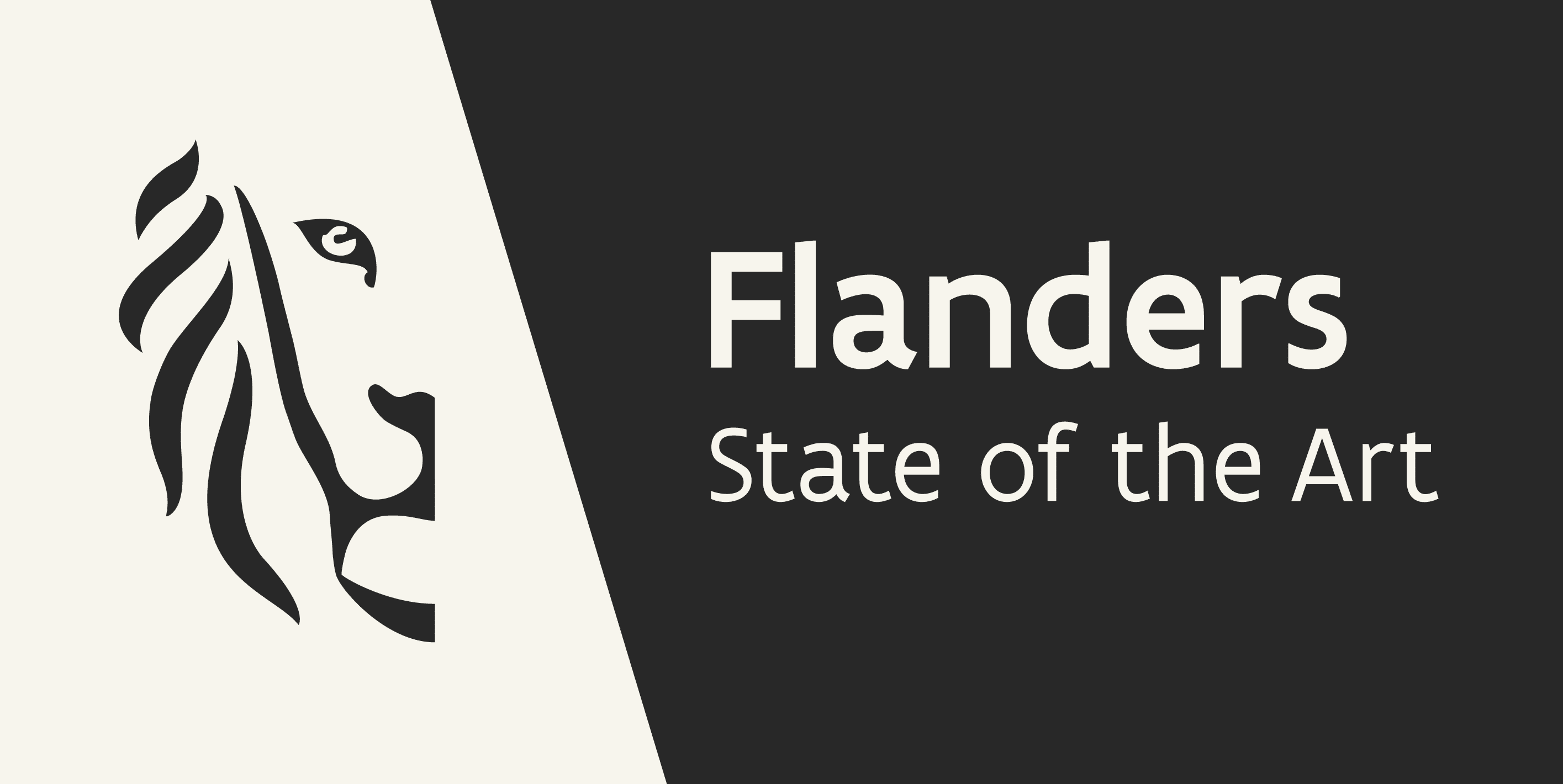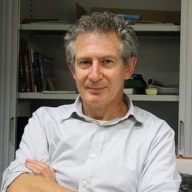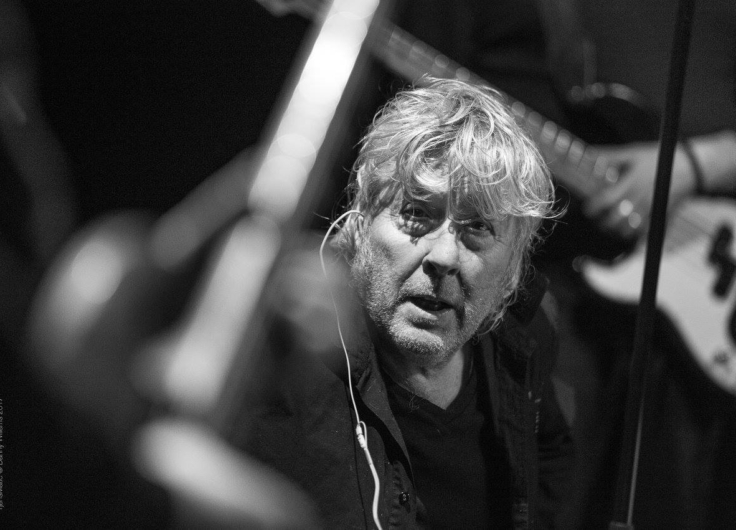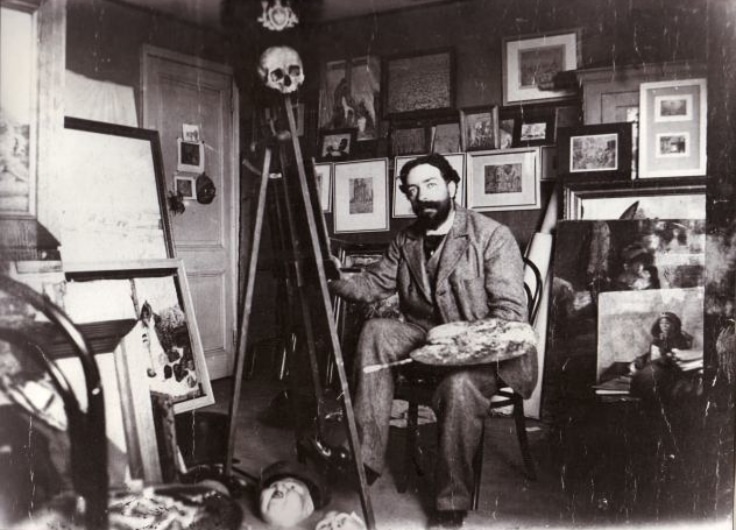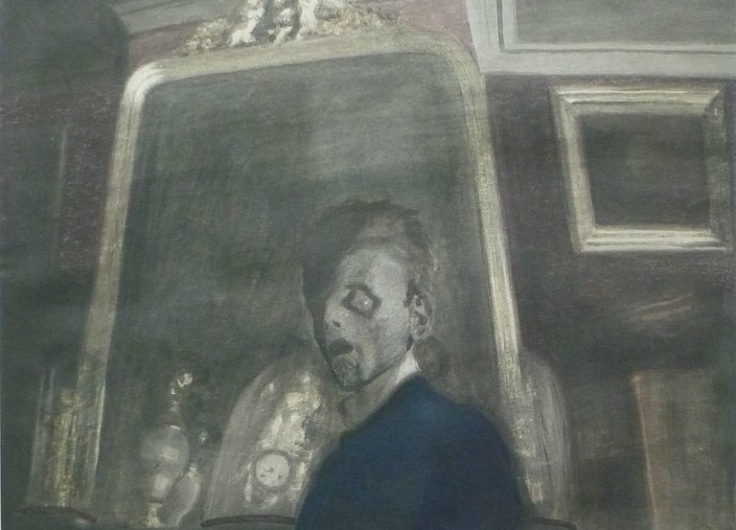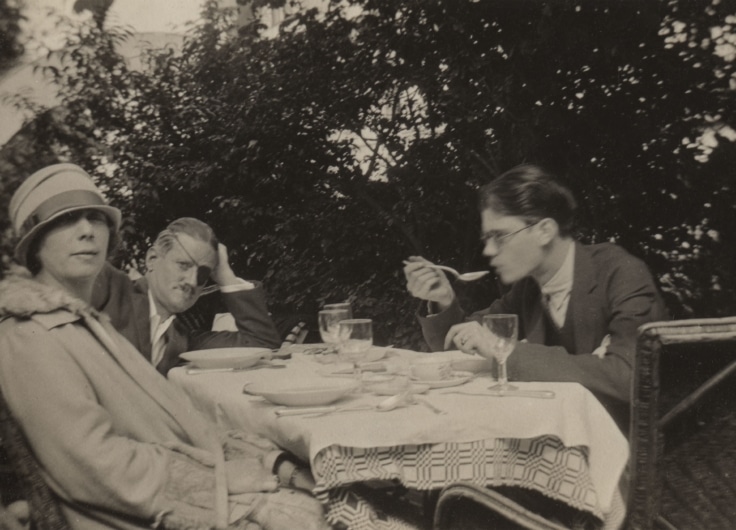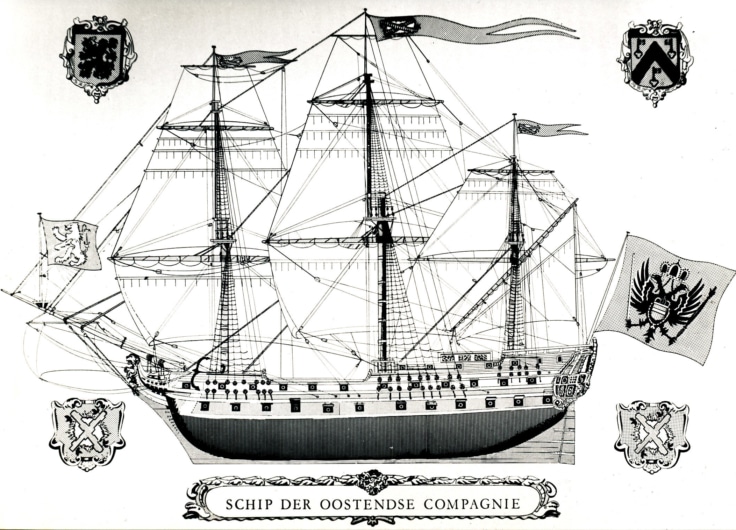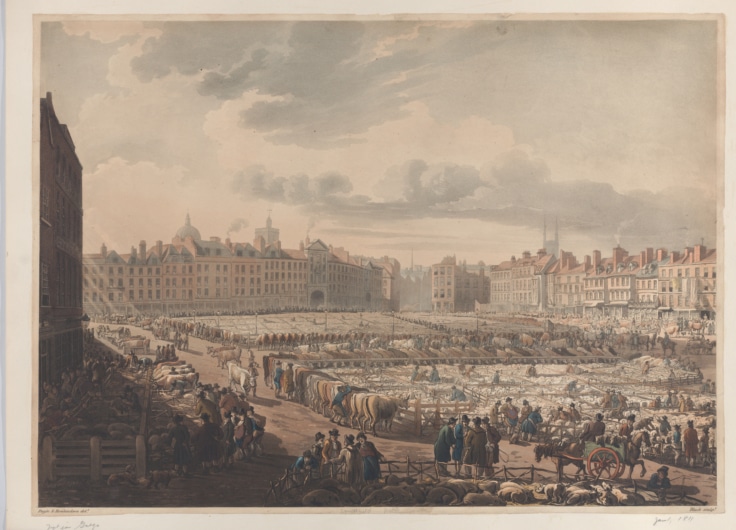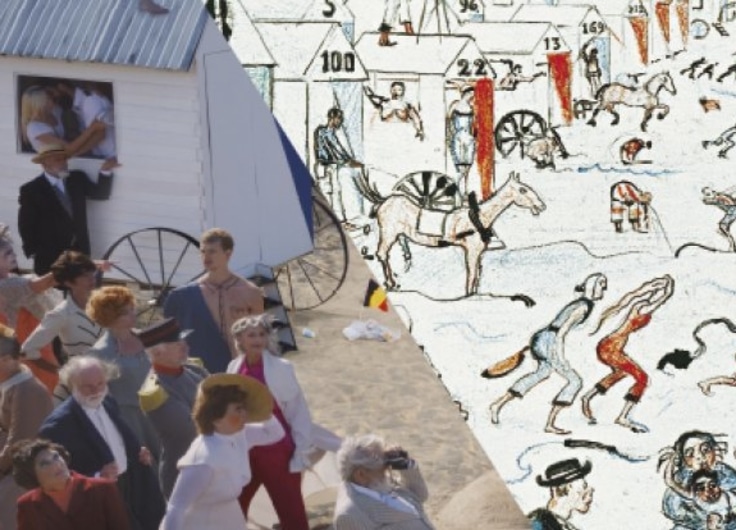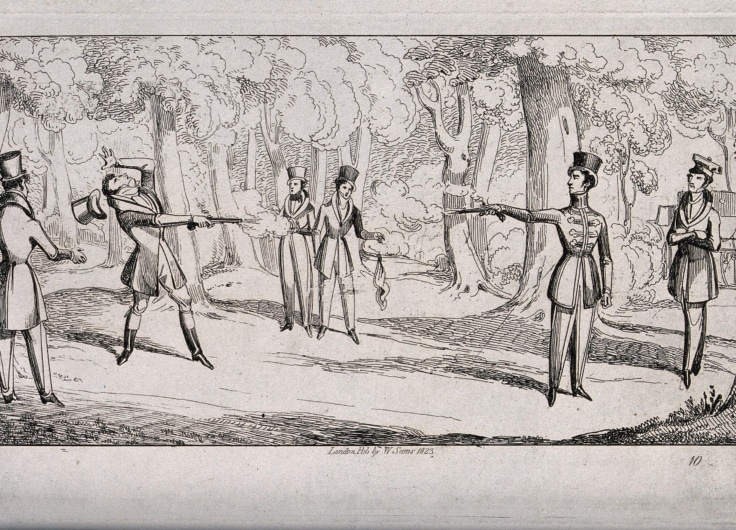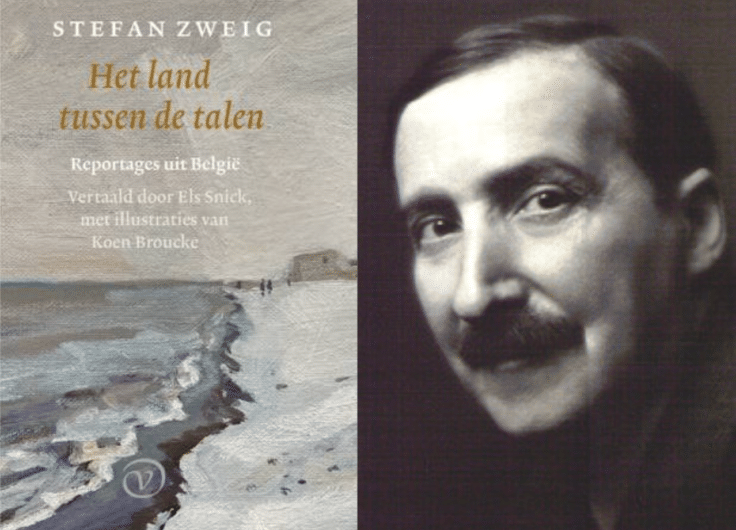On a visit to the Flemish coastal town of Ostend, Derek Blyth discovers grand architecture, a world-famous soul singer and the perfect shrimp croquette.
Ostend is different, I realised. I was sitting in the Hôtel Du Parc looking out on the busy Maria-José plein as the coast tram rattled past. Other resorts along Belgium’s North Sea coastline are small, touristy places. But Ostend seems like a real city.
The hotel’s brasserie has a faded Art Deco interior decorated with stained glass, wood-panelling and neon lamps. A couple, probably retired, were drinking Affligem beers, accompanied by one of those fluffy dogs that conveniently fit in a handbag. It could almost be Brussels.
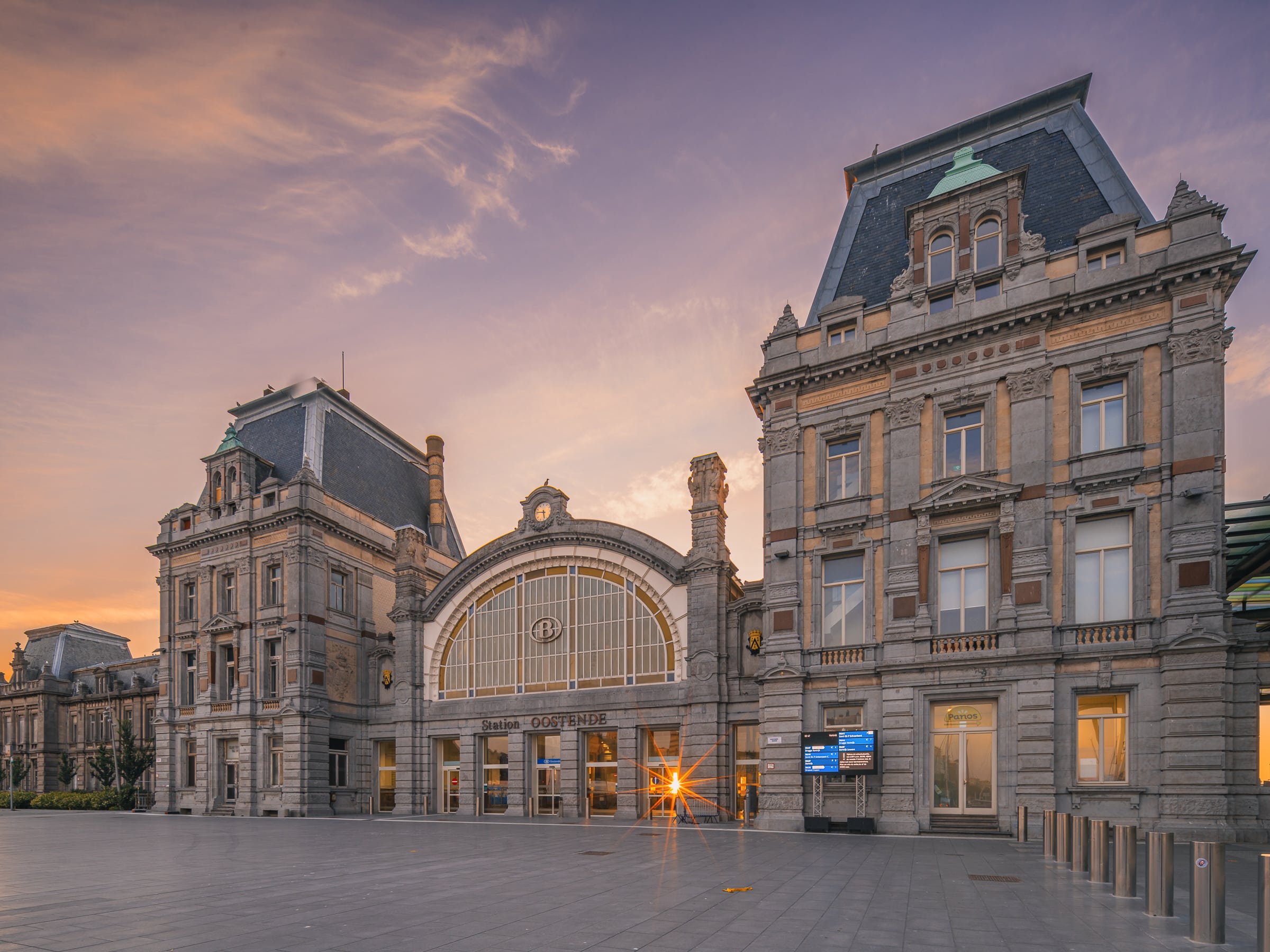 The grand station in Belle Epoque style
The grand station in Belle Epoque style© Kim Vanbesien
I was already aware of the grandeur before the train arrived at its destination. After crossing the misty, flat polders, the railway line into Ostend passes under a stone bridge decorated with massive sculpted locomotives. Then it draws into a grand station built in the imposing style of the Belle Epoque. Modern apartment buildings glinted in the sun. Seagulls screamed above clattering yacht masts. Children were impatient to get to the beach.
I had brought a book to read. Volker Weidermann’s Summer Before the Dark vividly tells the story of a group of exiled German writers washed up in Ostend in 1936. Fleeing from the Nazis, they found a safe haven in Ostend. Weidermann brilliantly captures this sad community of lost souls that included the writers Joseph Roth and Stefan Zweig. I had already noticed a photograph of the two writers hanging in the hotel lobby, although it was actually taken in a different hotel, now demolished, like most of Ostend’s grand hotels.
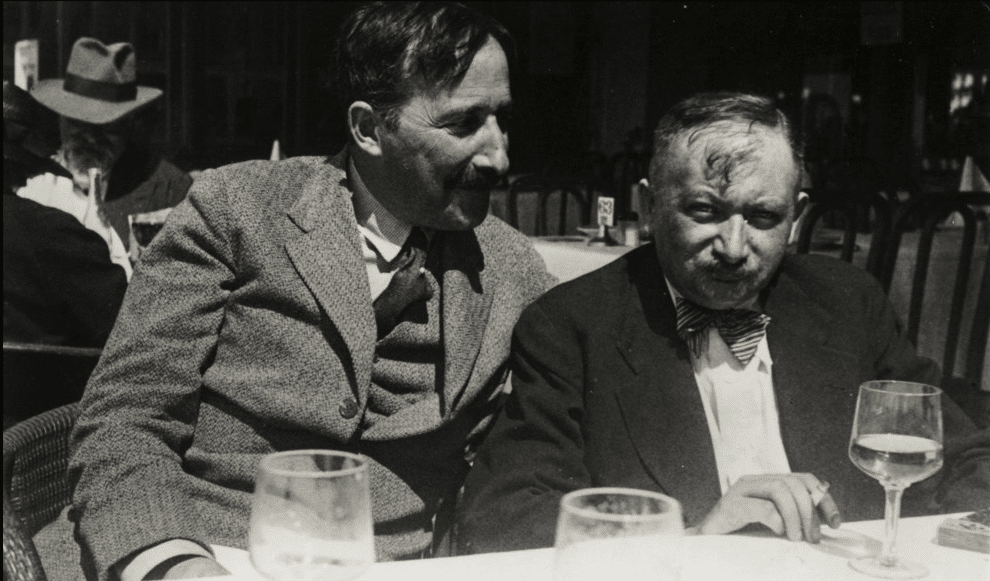 Stefan Zweig and Joseph Roth on a terrace in Ostend, summer 1936
Stefan Zweig and Joseph Roth on a terrace in Ostend, summer 1936© International Joseph Roth Society
No, I thought, Ostend is definitely not one of those upstart Belgian beach towns. It has history. A certain grandeur. Originally a fishing port, Ostend began to change in the late 18th century. In 1784, the expatriate William Hesketh introduced the odd English idea of sea bathing. The locals thought he was mad, but Hesketh built up a healthy business renting out stripy bathing costumes and selling lemonade. I had hoped there might be a statue of Hesketh somewhere in Ostend. Or at least a plaque. But he seems to have been forgotten.
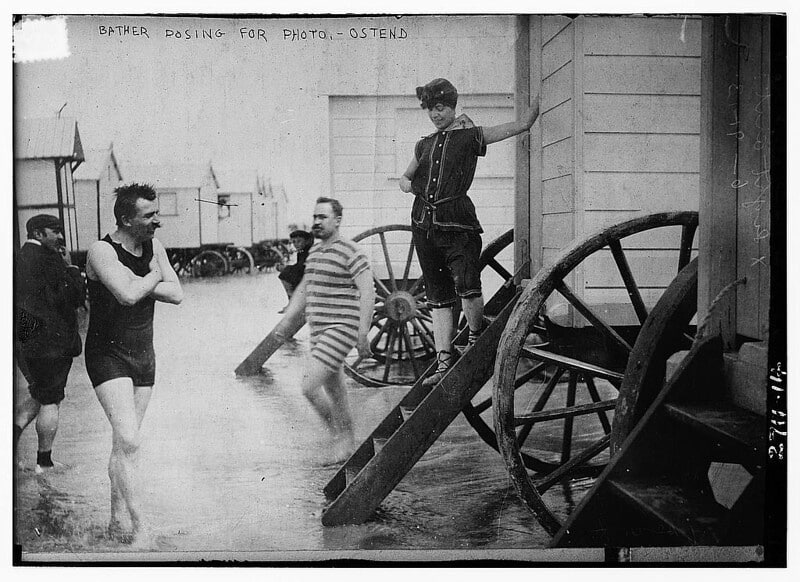 Bather posing for a photo in Ostend, June 1913
Bather posing for a photo in Ostend, June 1913© Library of Congress, Washington
I wondered if the City Museum might have something to say about the British entrepreneur. The museum occupies a grand palace in Langestraat where King Leopold I and his wife Louise-Marie spent their summers. It used to be a rather crumbling building with dusty rooms, creaking stairs and peeling paint. But it was recently restored.
The museum reveals that the earliest traces of a settlement date back to the fourth century. During the Dutch Revolt, the inhabitants resisted the Spanish until Albrecht and Isabella finally conquered it after a four-year siege. A fascinating historical painting in the museum shows the massive military machinery needed to bring the town to its knees.
The golden age of Ostend is richly illustrated with a nostalgic collection of travel posters, model ships and old photos of the fish market. The museum also has a fascinating room dedicated to the ferries that used to run between Dover and Ostend bringing thousands of 19th-century British travellers to the Belgian coast.
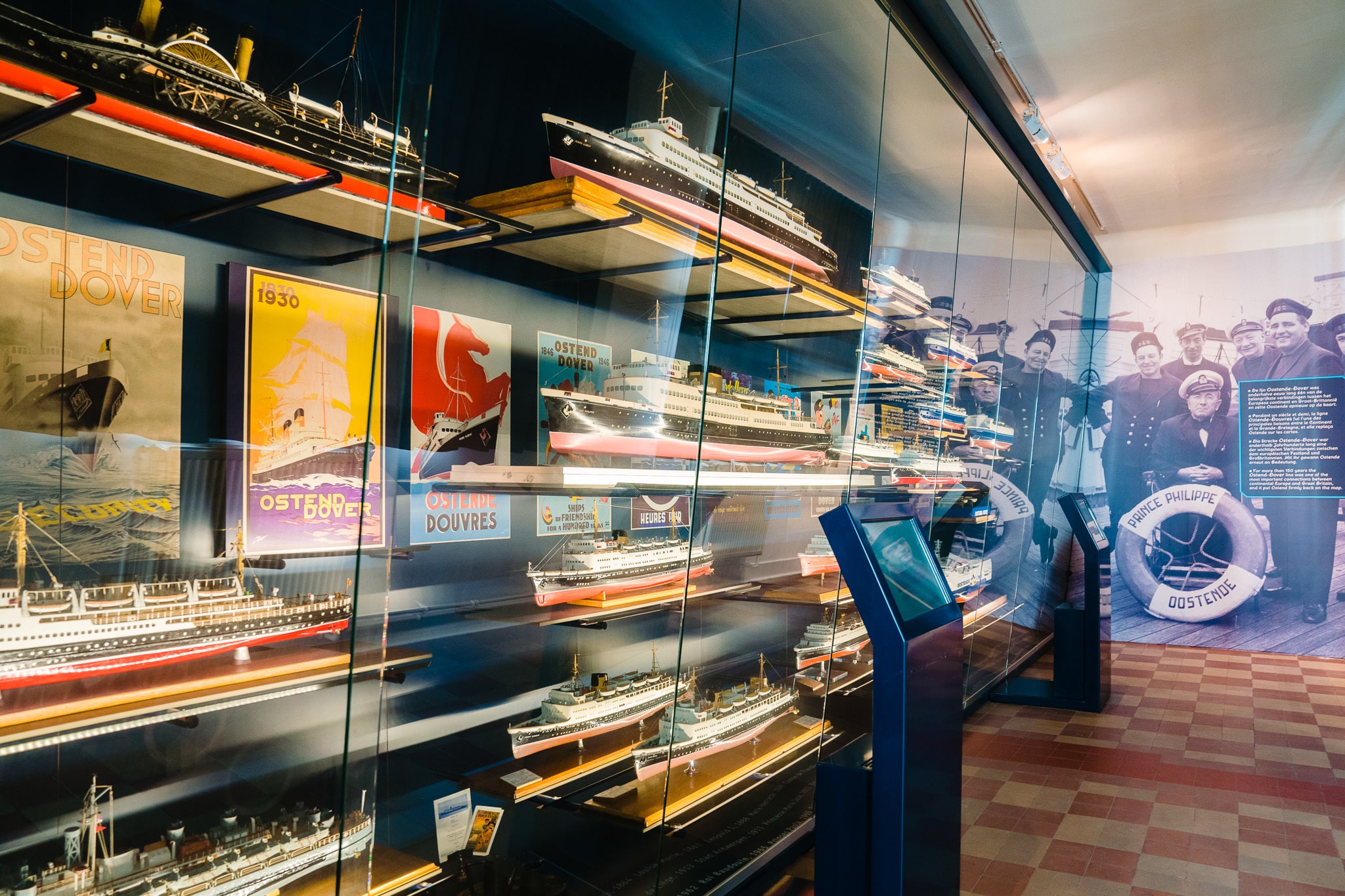 The museum has a room dedicated to the ferries that used to run between Dover and Ostend bringing thousands of 19th-century British travellers to the Belgian coast.
The museum has a room dedicated to the ferries that used to run between Dover and Ostend bringing thousands of 19th-century British travellers to the Belgian coast.© Nick Decombel
Adding to the building’s weirdness, the room where Queen Louise-Marie died of tuberculosis in 1850 has been preserved intact. A winding staircase leads up through the house to a tiny belvedere where the sickly queen would take in the sea view, after being hoisted up in a special chair.
For the British, many Continental adventures began in the Belgian port, including Lord Byron’s travels in 1816 and Charlotte Brontë’s stay in Brussels in the 1840s. After a regular steamer service was launched in 1846, the crossing to Ostend became a popular literary theme, from Katharine Mansfield’s short story The Journey to Bruges to the customs house scene in D.H. Lawrence’s Women in Love.
But then the Channel Tunnel
opened in 1994. Soon, no one wanted to cross the heaving North Sea in a ferry that stank of fried food. The last Dover-Ostend ferry sailed in 1994 (although the service was briefly relaunched a few years later). The port that had linked Belgium and Britain for 150 years had to find another way to fill its hotels.
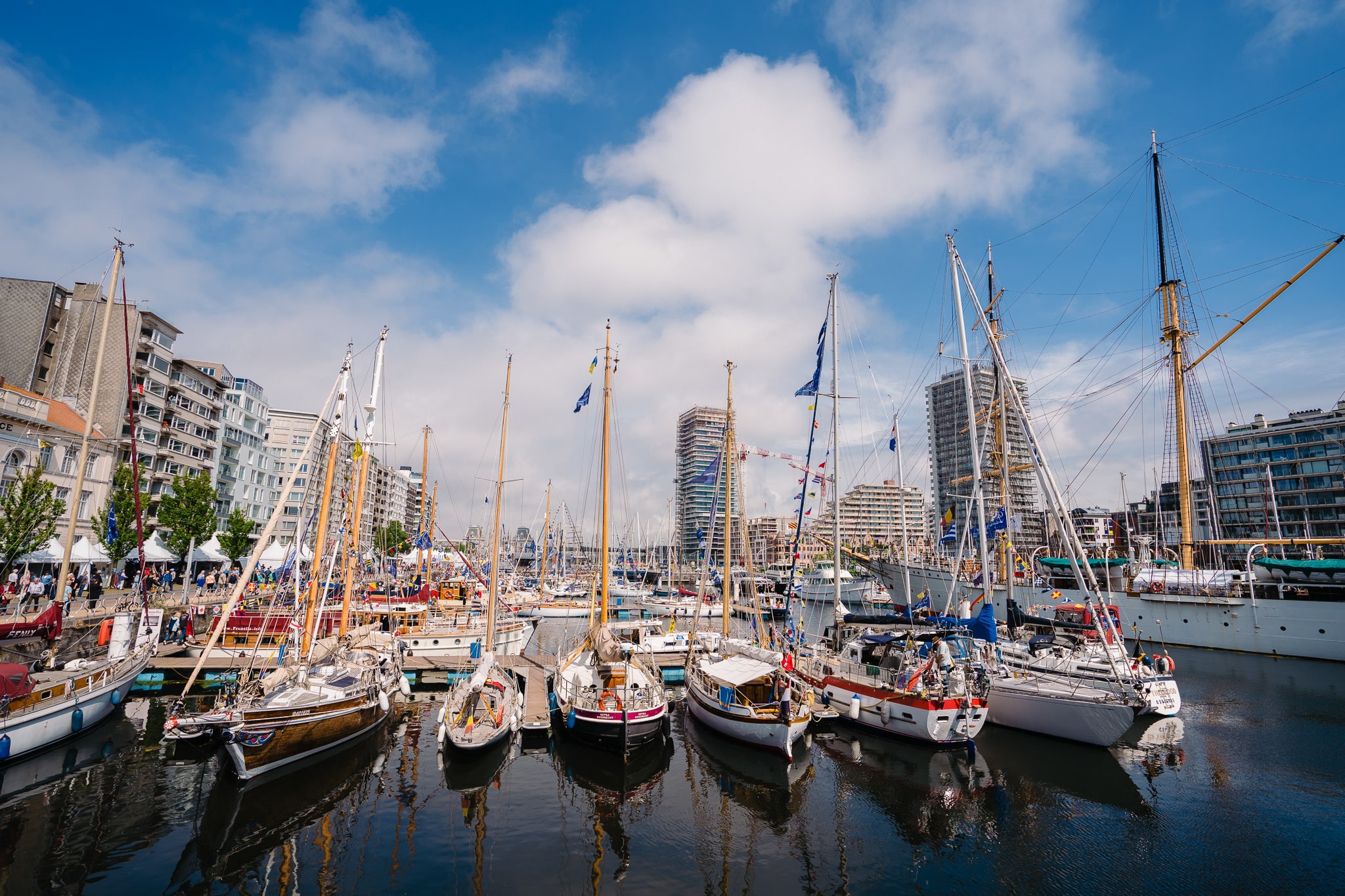 Ostend Harbour
Ostend Harbour© Nick Decombel
As I walked through the busy Ostend streets, I noticed the absence of English voices. According to recent tourist office figures, the British now represent just four percent of visitors, compared to 20 percent when the ferries were running. A few locals still hope the ferries might return to the port. ‘The ferry is part of the soul of the town,’ said Danny Drooghenbroodt of the local group Restart Ferries. ‘Every day that goes by feels like a loss.’
It looks unlikely the ferries will ever come back, but Ostend harbour is still a lively spot with boats landing fish in the early hours and seafood stands lined up along the quayside. Founded in the 19th-century, the Vistrap (fish market) is open almost every day of the year, except when the sea is too rough to set out in a small fishing boat.
 Fish for sale at the Vistrap
Fish for sale at the Vistrap© Visit Oostende
The stalls are mostly run by local fishermen’s wives who remain cheerful even when a fierce gale blows in off the sea. Everyone in Ostend has their favourite fish stall. I stopped at the stand 0.62, named after the fishing boat that lands its catch there. It is run by a father and daughter from an Ostend fishing family who have worked the sea for six generations.
Then I set off along the Albert I Promenade looking for traces of grandeur. To be honest, there is not much of that. The grand hotels have all gone, one by one, to be replaced by monotonous apartments built in the 1960s and 1970s. There are hardly any old buildings still standing, apart from the solitary Villa Maritza, a beautiful seaside mansion from 1885 that now looks slightly ridiculous squeezed between two tall apartment buildings.
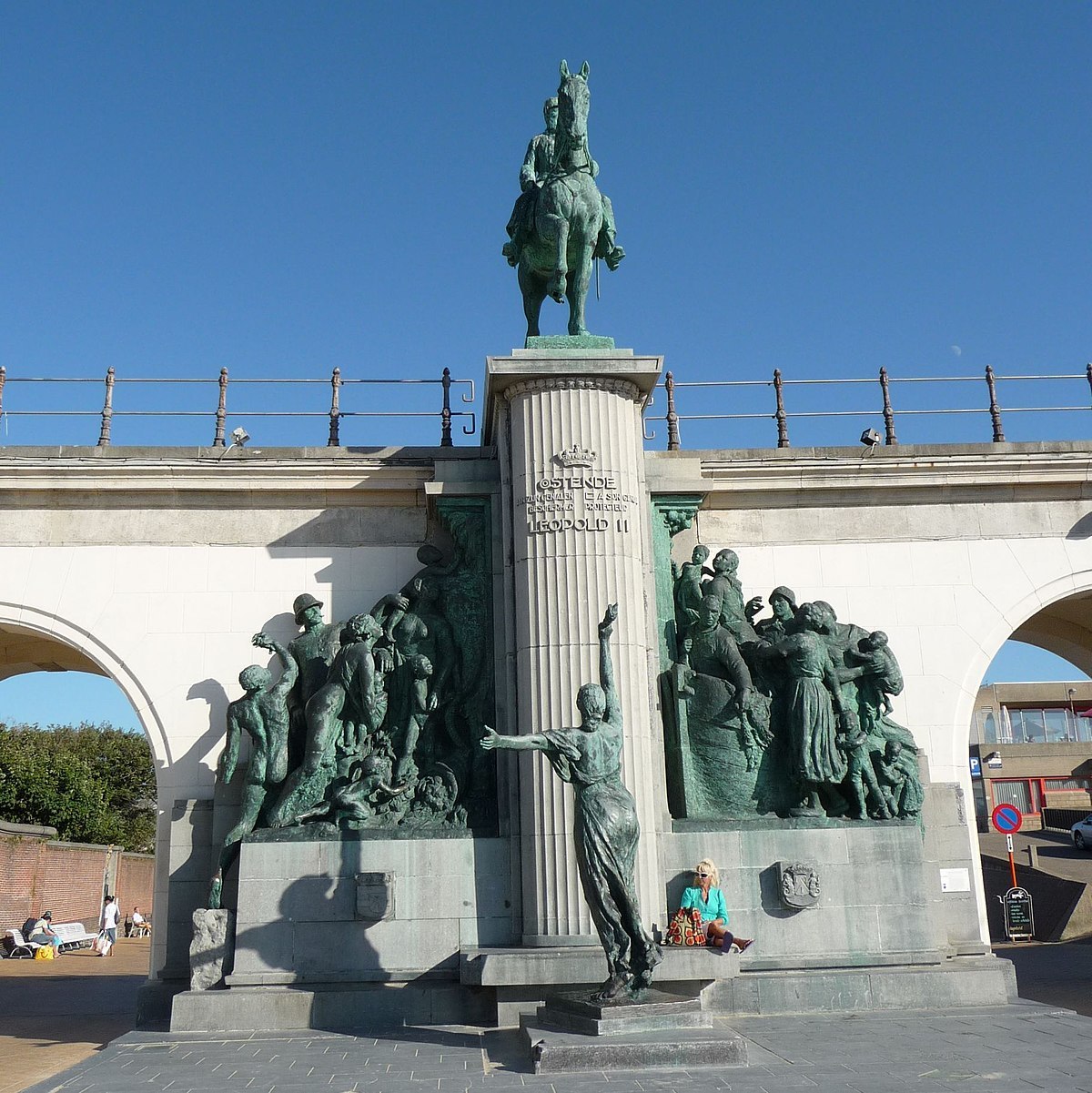 'The Grateful Congolese', a controversial monument dedicated to King Leopold II.
'The Grateful Congolese', a controversial monument dedicated to King Leopold II.© Wikipedia
I had come to look at a massive bronze monument dedicated to King Leopold II. The king sits proudly on his horse facing out to sea. A series of figures represent Congolese people worshipping the king, together with with a group of Ostend fishermen. The sculpture is titled The Grateful Congolese.
It should be removed, some people think. Long before Black Lives Matter, a mysterious anarchist group called De Stoeten Ostendenoare (The Sturdy Ostender) was protesting at crimes committed in Leopold’s African colony. In 2004, they hacked a hand off one of the figures to draw attention to Leopold’s ruthless policy of punishing Congolese by cutting off a hand. More recently, they poured red paint over a bust of Leopold, and called for it to be removed.
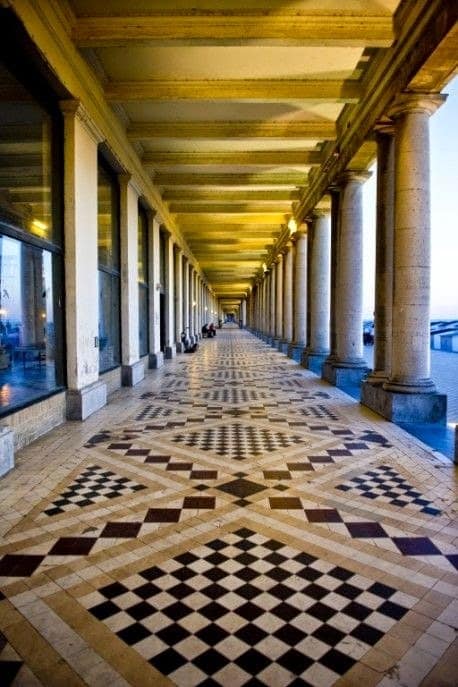 The Venetian collonade
The Venetian collonade© Visit Oostende
But some people in Ostend still defend Leopold II, who gave Ostend its haughty grandeur. Funnelling wealth from the Congo, he employed his favourite architects to build a grand Venetian colonnade, a royal villa and a Hippodrome. He also added wooden stables in an eccentric Norwegian style, as well as planting a Japanese garden behind a high wall in the royal park.
Leopold turned Ostend into the grandest resort on the North Sea. It became known as la Reine des Plages, the Queen of Beaches, attracting a steady flow of royalty, dukes, industrialists and generals. But there was always something seedy about the place. Behind the grand hotels and seaside villas, there were dark streets with louche bars.
The eccentric artist James Ensor fitted perfectly into this dubious seaside resort. The son of a melancholy British father and a stern Flemish mother, he spent his entire life in Ostend. The house where he lived was a weird little place near the seawall with a cluttered souvenir shop on the ground floor and a stuffy living room on the first floor filled with odd seaside relics, fancy hats and reproductions of his paintings. In a country of eccentric artists, James Ensor stands out as one of the most bizarre. His works featured Carnival processions, beach crowds and masked revellers.
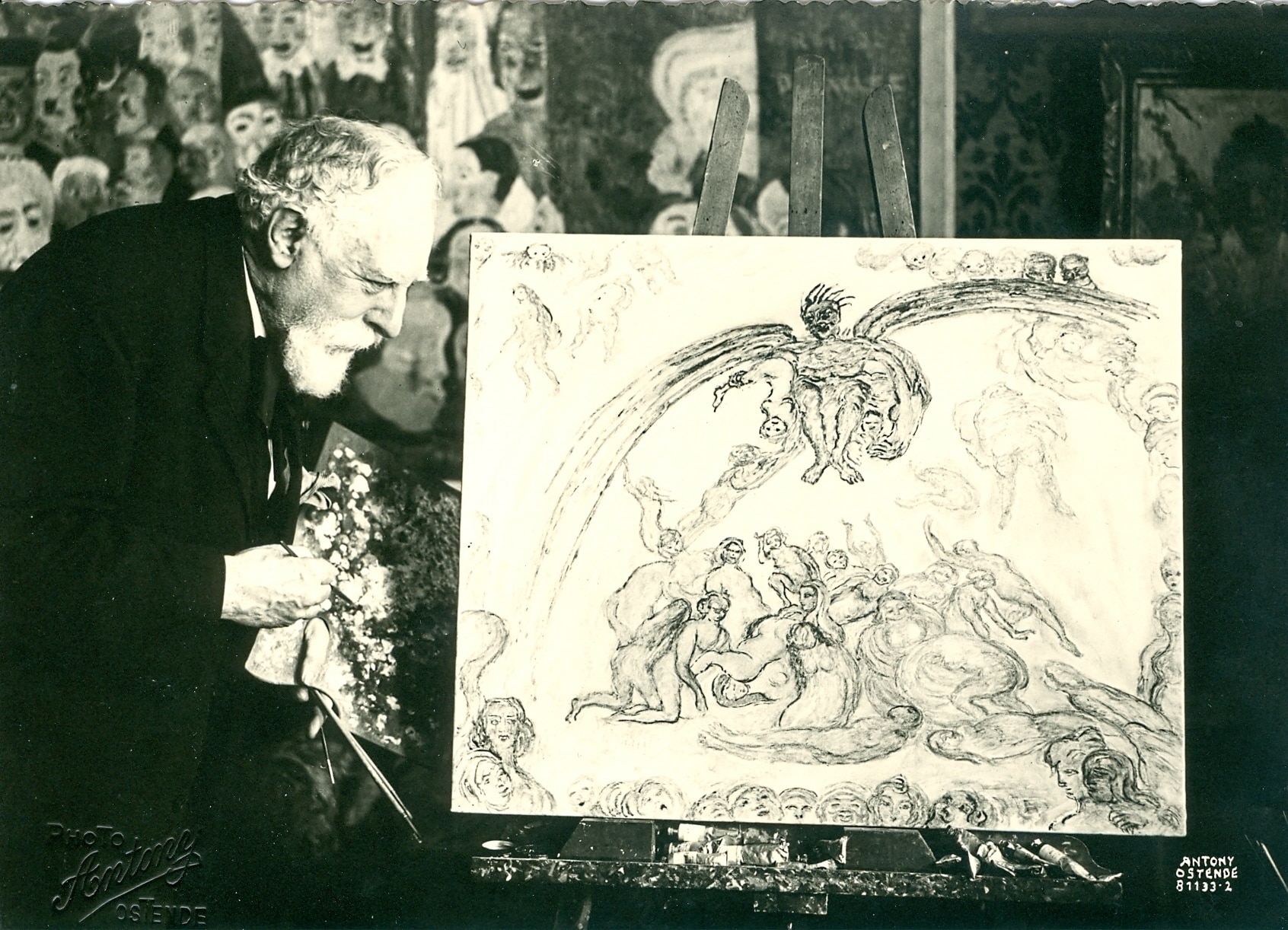 Painter James Ensor in his studio
Painter James Ensor in his studio© Antony
The James Ensor House used to be a modest little museum that got a few visitors. The city was so uninterested in the artist that it permitted the demolition in 2000 of a corner building where Ensor had an attic studio. But then Ostend began to realise that Ensor was more than a local eccentric. The turning point came in 2016 when Ensor’s 1891 painting Skeletons Arresting Masked Revellers fetched a record-breaking $7.8 million at Sotheby’s.
The local council started work on a new Experience Centre in the former Hôtel Providence Regina next door to Ensor’s house. The new museum designed by Bruges architects noArchitecten opened in 2020. To mark the opening, the museum commissioned Antwerp photographer Athos Burez to create a modern version of Ensor’s satirical beach scene The Baths at Ostend.
The original, painted in 1890 and now hanging in Ghent’s Museum of Fine Arts, features dozens of figures on the beach, including amorous couples, solemn priests and the occasional frisky dog. Burez painstakingly recreated the scene on Ostend beach after marshalling a cast of 180 people, a team of stylists, two horses and some playful dogs. With the help of digital techniques, he recreated many of the eccentric details in the original, including a portly man in a stripy bathing costume, a kissing couple and a filmmaker perched on a beach hut. He even persuaded the curator of the Ensor Museum to stand in for the eccentric artist.
The photographer went on to add contemporary touches, such as a boat filled with refugees (modelled on Géricault’s Raft of the Medusa), piles of abandoned rubbish and daytrippers with their cold boxes. This intriguing composition now hangs in the entrance hall next to a large digital version of the original.
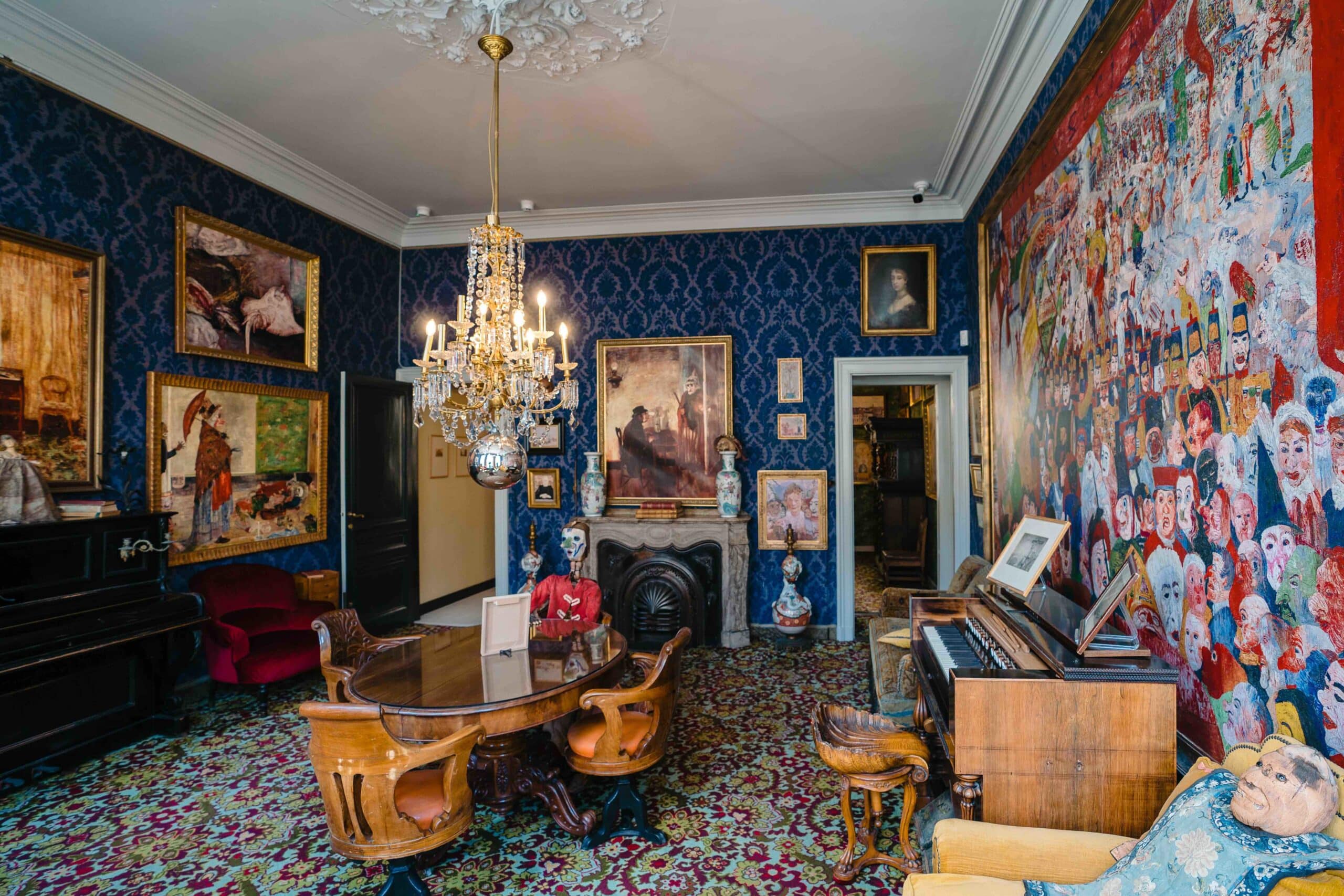
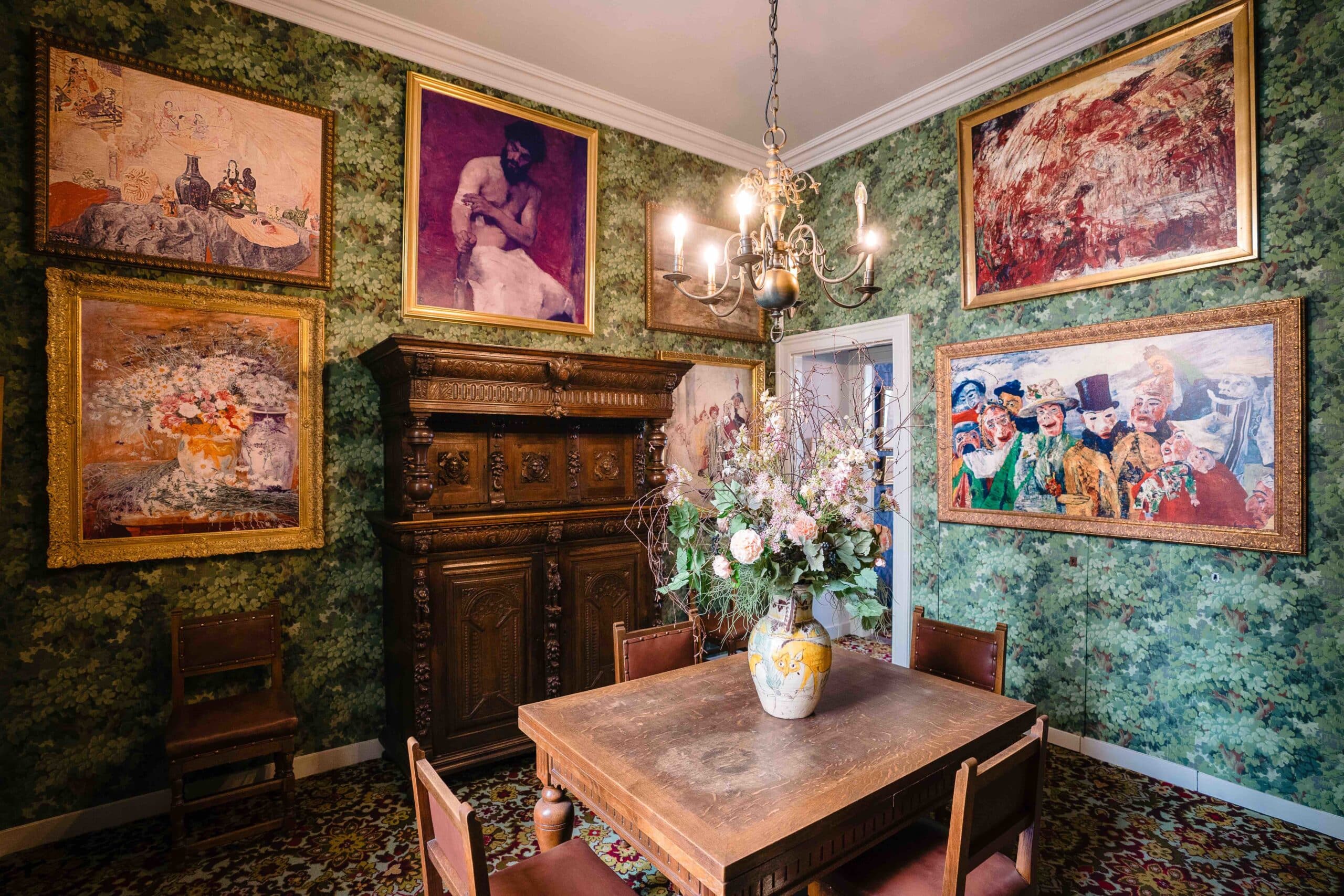 The living room of James Ensor
The living room of James Ensor© Nick Decombel
The museum tour leads into rooms dedicated to Ensor’s life that include reproductions of paintings, period photographs, a rare film and a reconstruction of his attic studio. It also leads visitors into the dark, mysterious souvenir shop run by Ensor’s aunt and then upstairs to the living room furnished with heavy old furniture, odd masks and creepy skulls. It is the closest you will ever get to Ensor’s strange world.
But Ensor wasn’t the only artist to find inspiration in Ostend. The pale, permanently ill symbolist Léon Spilliaert
spent endless sleepless nights wandering the gloomy colonnades and deserted promenade. When the town renovated its seawall in 1998, the sculptor Herlinde Seynaeve created a Hommage to Spilliaert modelled on his mysterious painting Vertigo. This ambitious installation shows a solitary girl standing on a circular monument with her hair blowing in the wind.
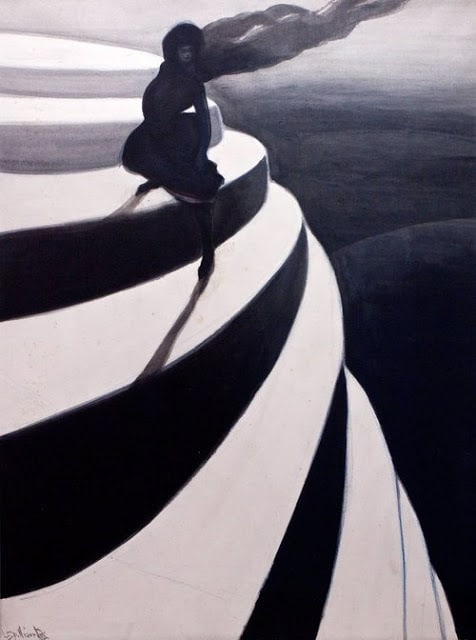
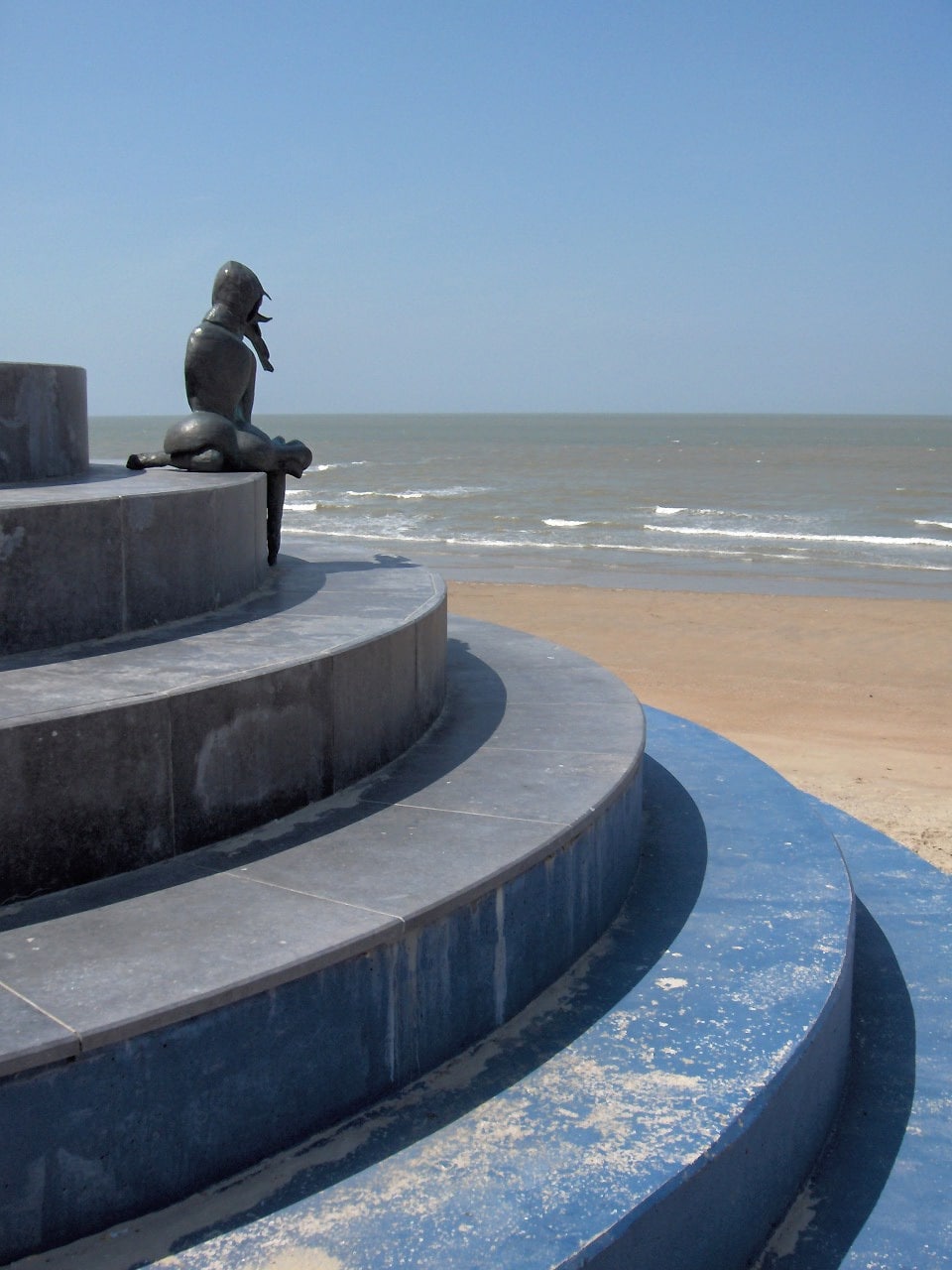 Léon Spilliaert, Vertigo, 1908 / Herlinde Seynaeve, Umbra, 2002
Léon Spilliaert, Vertigo, 1908 / Herlinde Seynaeve, Umbra, 2002Finally, Ostend decided to drop its claim to be the Queen of the Belgian Beaches. It had become too grubby to live up to the image. Instead, it came up with the ambitious idea of becoming an art city on the coast. It wasn’t such a bad concept. Ostend had Ensor and Spilliaert. It also had writers and sculptors.
The city began to assert its new identity in 2008 when the art museum Mu.ZEE opened in a modernist department store designed by Gaston Eysselinck. In 2016, the museum opened a new wing dedicated to Ensor and Spilliaert. The vast white interiors provide a striking background for an eclectic mix of paintings, documents and photographs illustrating Ostend in its glory years.
Four years later, Eysselinck’s stunning post office of 1947 was renovated by Antwerp architects B-architecten to house De Grote Post cultural centre. The CultuurCafé inside De Grote Post has become a meeting spot for Ostend’s growing community of artists, writers and gallery owners. The old telephone cabins along one wall now frame Pieter Clicteur’s large photographs of 12 Flemish creatives, from graphic designer Eva Mouton to actor Wim Opbrouck.
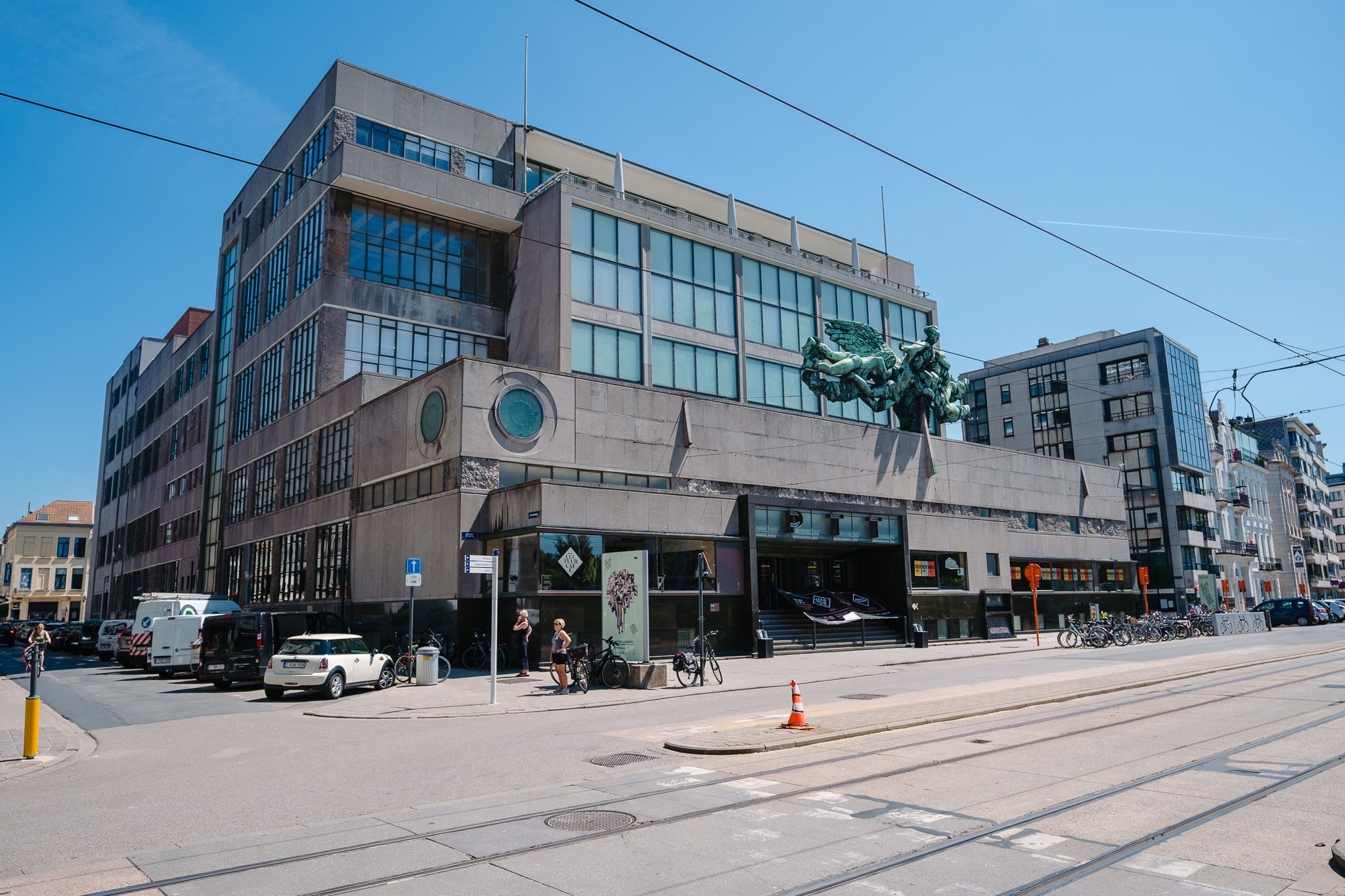 De Grote Post, a post office turned into a cultural centre
De Grote Post, a post office turned into a cultural centre© Visit Oostende
The sea change didn’t stop there. The town’s launched another bid to attract the art crowd in 2016 when 25 Belgian and international street artists were let loose on the city’s blank walls. There are now more than 70 works dotted around the streets, from Flemish paintings reproduced by Julien de Casabianca to tiny cartoon birds by Bué the Warrior. With the aid of a free map from the tourist office, you can spend a couple of hours tracking down various works, including a pile of sleeping animals by the Ghent street artist ROA and a tiny figure of a man on a balcony by the Spanish artist Isaac Cordal.
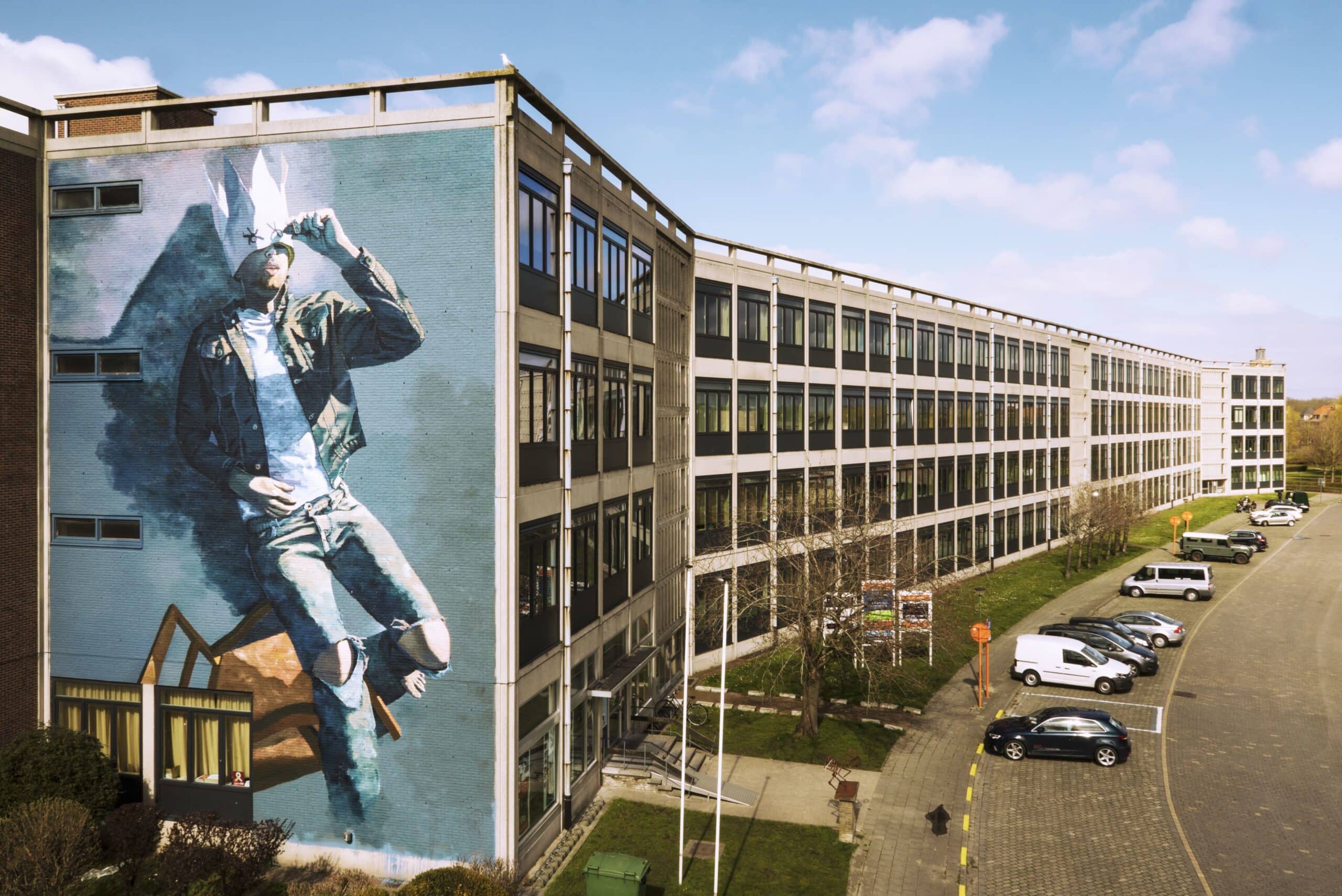
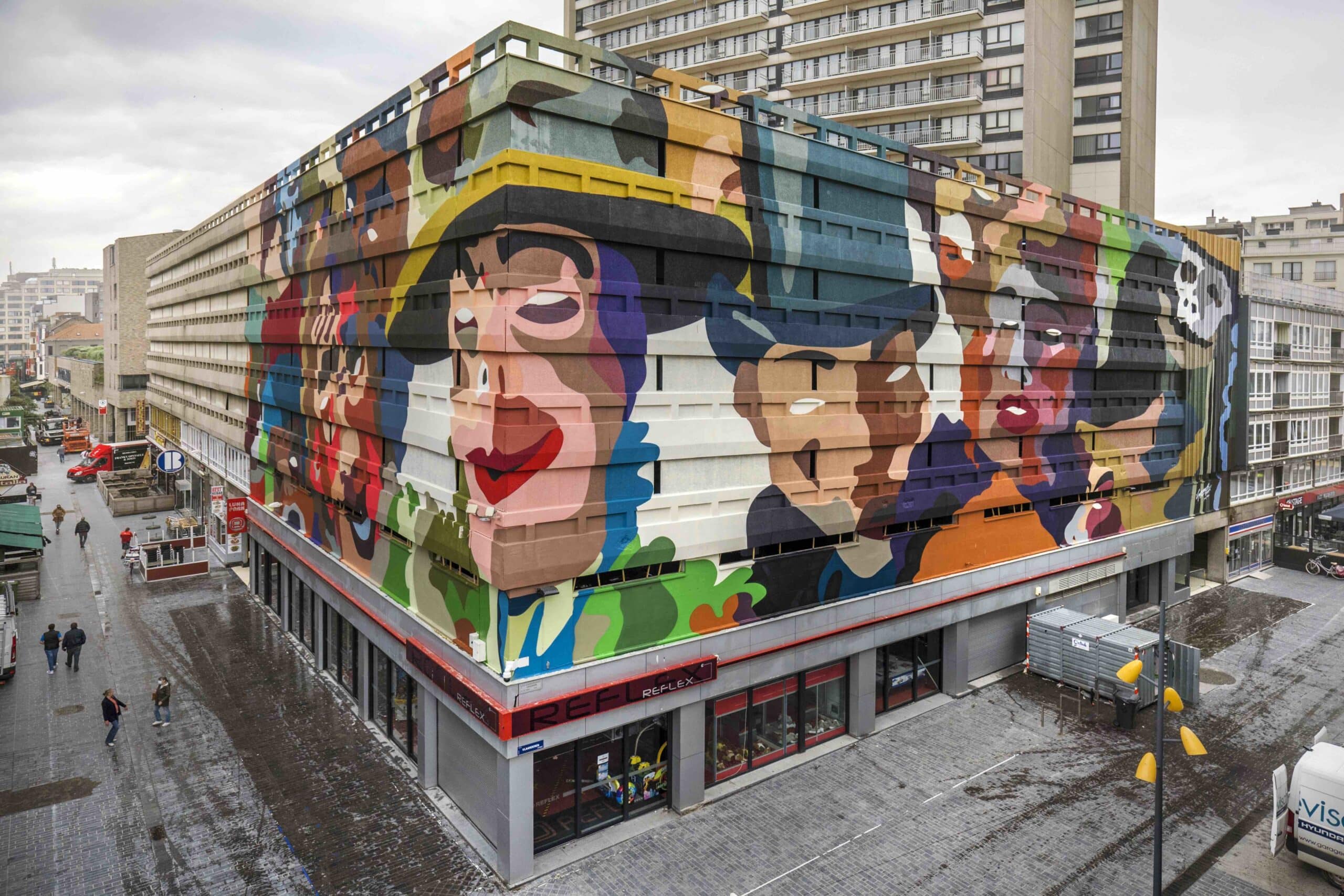
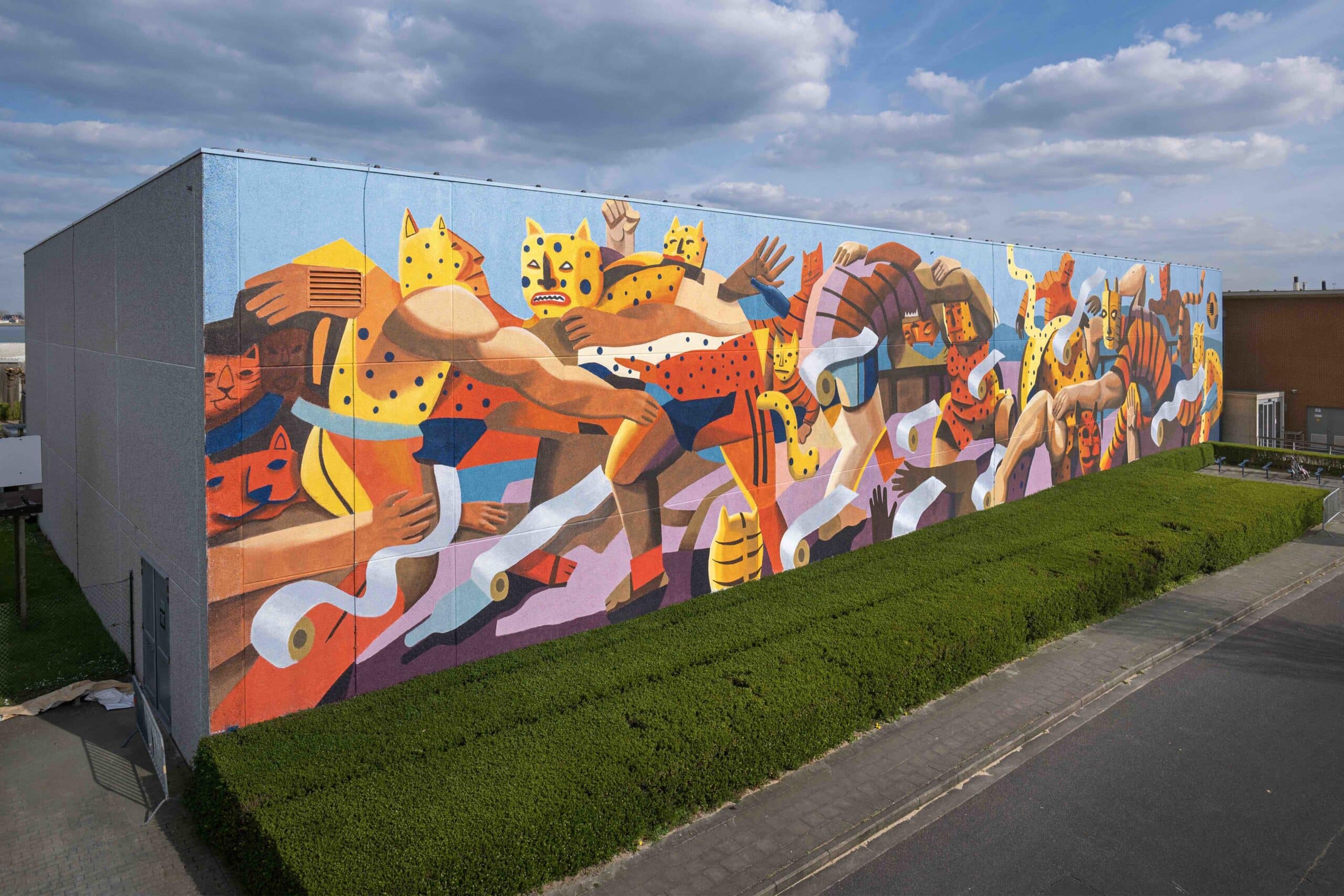 Some of the murals made for the annual street art project The Crystal Ship
Some of the murals made for the annual street art project The Crystal Ship© Visit Oostende
The culture plan seems to be working. Ostend is now a stimulating weekend destination with its museums, trendy restaurants and hip coffee bars. It has also developed a strong programme of annual festivals, from Theater aan Zee to the Ostend Film Festival. In 2022, the city added a book festival and podcast festival to its annual schedule.
More than anyone, the Belgian rock singer Arno, who died earlier this year, captured the spirit of Ostend. His song Ostende bonsoir is the perfect track to play while you wander past the slightly louche bars on Langestraat late at night. Je suis seule avec toi Ostende bonsoir, he sings in his deep drunken growl – ‘I’m alone with you, good evening Ostend’. The song title inspired a series of podcasts called ‘Ostende bonsoir’ in which local creatives were interviewed in a hotel room looking out on the sea.
The city has honoured its famous son with a large mural on the side wall of the town hall. He is the perfect person to symbolise this rough port city. His songs, sung in different languages, mirror the chaotic mix of languages you hear all around you – the French and Dutch and English of tourists, along with Ostend dialect thrown into the pot.
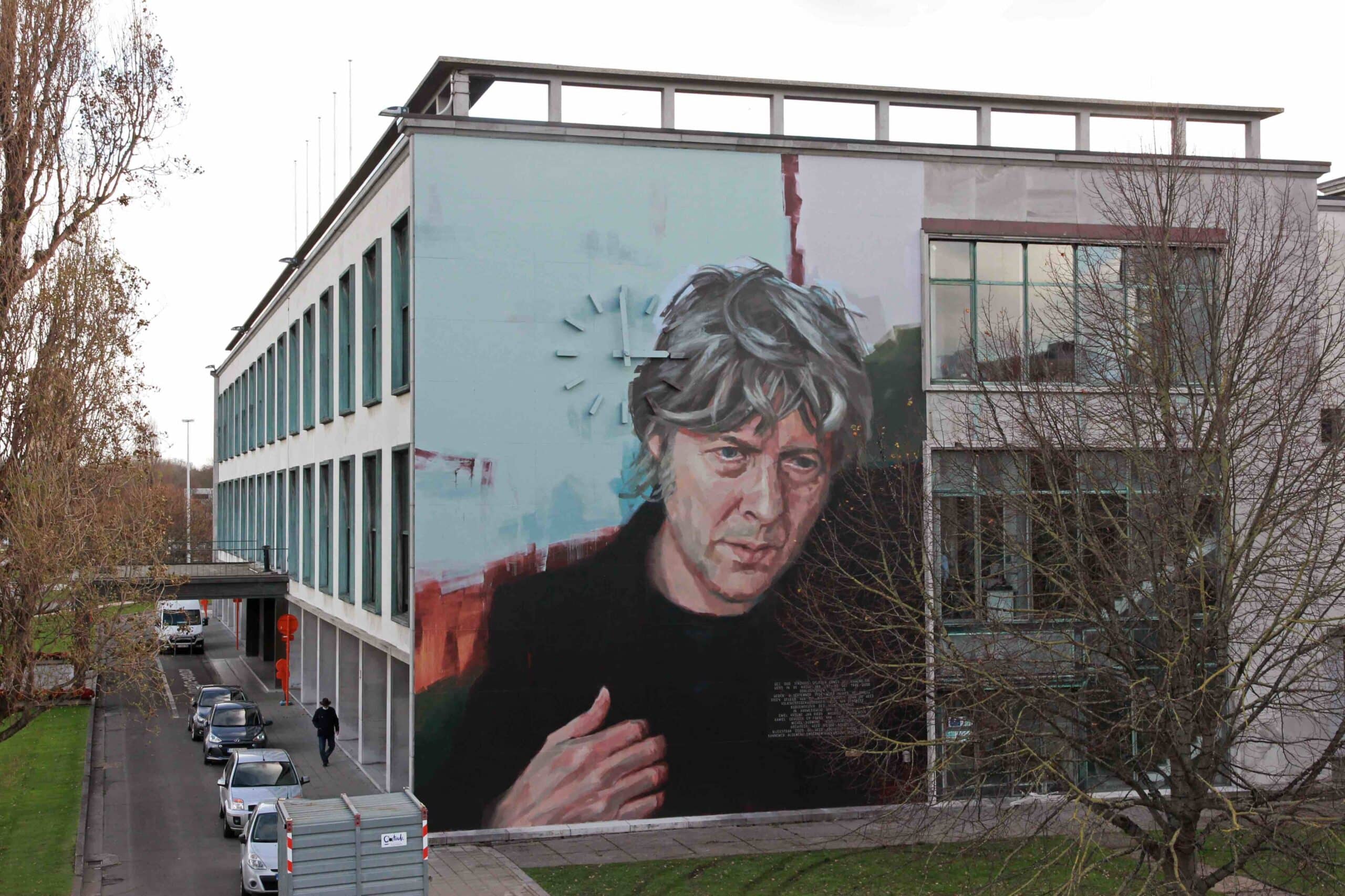 Mural of singer Arno by Helen Bur on the side wall of the city hall.
Mural of singer Arno by Helen Bur on the side wall of the city hall.© Helen Bur
The city has also started to put up interesting new architecture while renovating several of the older buildings. The most ambitious project so far is the redevelopment of the Oosteroever district (East Bank district) on the east side of the harbour. Up until recently, no one came here, apart from local fishermen. But a ferry link from the Visserkaai – behind the stalls where fishermen’s wives sell fresh shrimps – has revitalised this area.
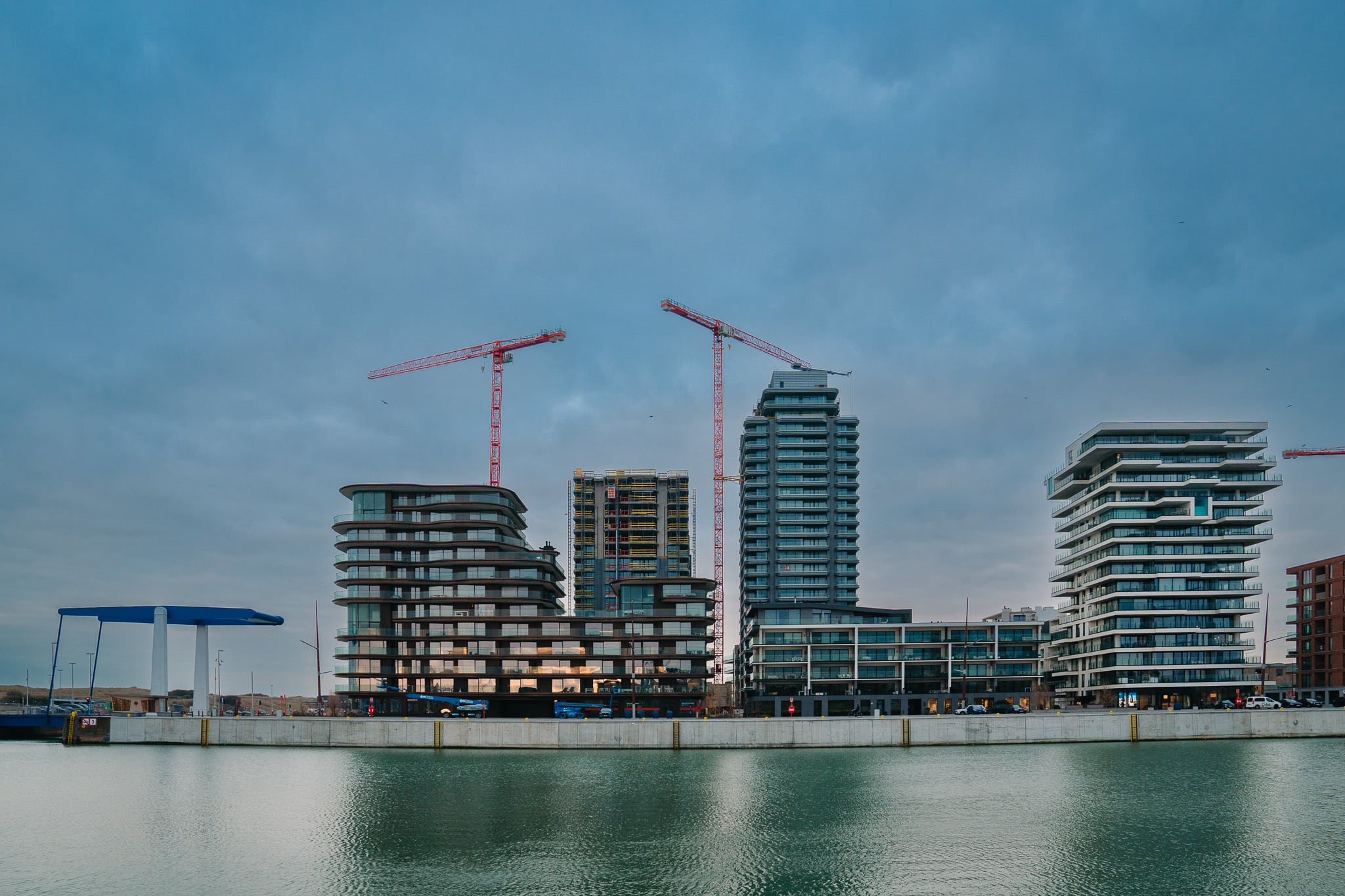 The East Bank is in full development. Several tall apartment buildings are rising above the old harbour.
The East Bank is in full development. Several tall apartment buildings are rising above the old harbour.© Nick Decombel
I hopped on the little ferry to take a look around this unknown quarter with its mix of abandoned fishing boats, old military bunkers, a Napoleonic fort and windswept dunes. A breakwater leads out to the prow of the British battleship Vindictive that blocked Ostend harbour during the First World War.
It might turn out that the raw atmosphere does not last much longer as the East Bank has now been discovered by property developers. Several tall apartment buildings are rising above the old harbour and along the edge of the vast inland reservoir Spuikom.
‘You need to eat an Ostend shrimp croquette
before you leave,’ I was told by a local. ‘Especially now the Oostendse garnaalkroket has been recognised as part of Flanders ‘edible heritage’. As well as City on the Sea, Ostend has started calling itself the Capital of the Shrimp Croquette. The local delicacy even has its own festival held in October at the Hippodroom race course.
 A delicacy from Ostend: the shrimp croquette
A delicacy from Ostend: the shrimp croquette© Visit Oostende
‘Where do you recommend I go for garnaalkroket?’ I asked. ‘Well, there’s Café Botteltje, a friendly old-fashioned place, or there’s Bistro Mathilda, which is more smart. But there’s a little place on the promenade I think you would like. It’s called Toi, Moi et la Mer.’
And I did. It was a busy, friendly restaurant with a simple lunch menu – Garnaalkroket, followed by fish fresh from the quayside and naturally a bowl of Belgian frietjes. The croquette was perfectly done with a generous filling of shrimps topped with sprig of fried parsley.
I ended the day in the café-gallery BeauSite. With its sweeping view of the North Sea, this Art Deco spot has become a hotspot for artists. The interior is filled with an odd mix of vintage plastic furniture, satirical prints and ornaments. But perhaps the most intriguing object is a large photo of Marvin Gaye on Ostend beach.
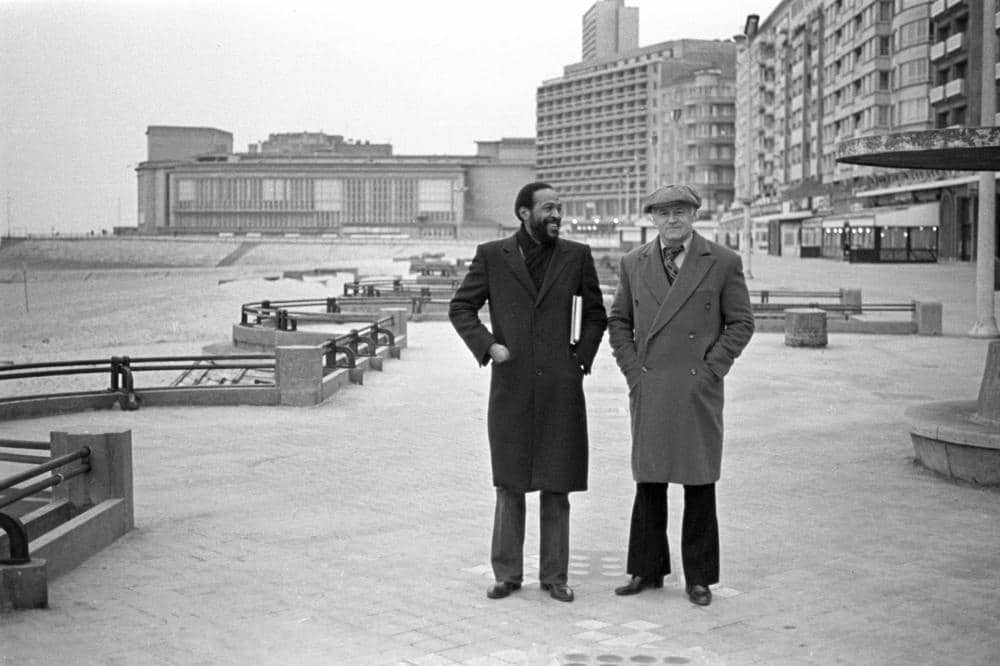 Marvin Gaye and Freddie Cousaert near the beach, 1982
Marvin Gaye and Freddie Cousaert near the beach, 1982© Jean-Jacques Soenen / Visit Oostende
On a cold December morning in 1981, the soul singer boarded a ferry from Dover to Ostend. Like many people washed up in this beach town, the Motown singer was running away from his past. Struggling with drug addiction, a broken marriage and money problems, he desperately needed a safe haven.
The Ostend club owner Freddy Cousaert came to his aid. He put him up in his seafront apartment at Albert-I promenade 77 and encouraged the singer to go for healthy runs in the dunes. ‘I’m an orphan at the moment,’ Gaye complained in an interview, ‘and Ostend is my orphanage’.
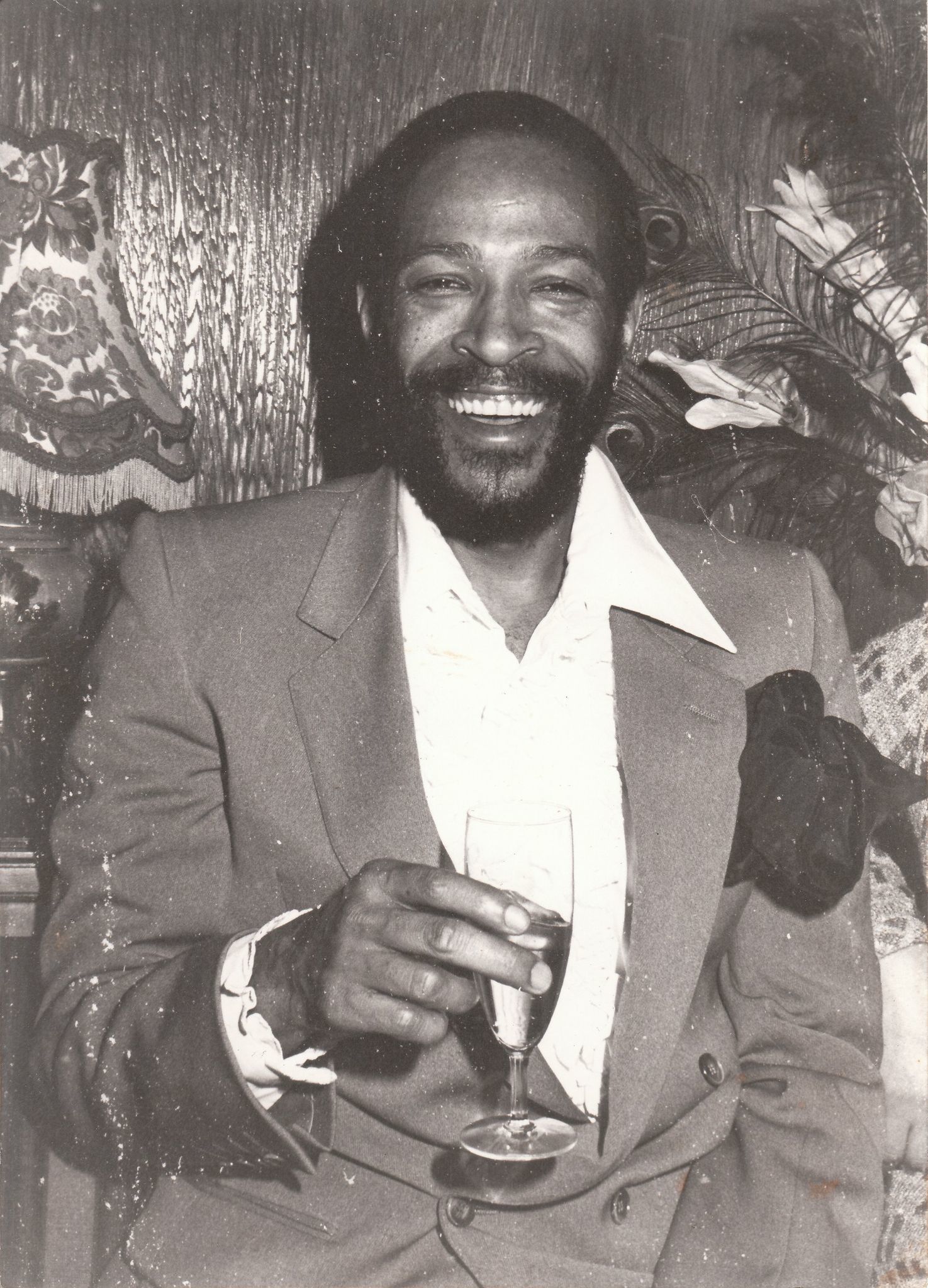 Marvin Gaye in Ostend
Marvin Gaye in Ostend© Visit Oostende
The sea cure worked, at least briefly. Gaye wrote the soul song Sexual Healing
while living in Ostend. Considered one of the greatest love songs of all time, it can be tracked down on YouTube, where the original video, last time I looked, had logged 164 million views and more than 27,000 comments. ‘Chances are someone is getting laid to this tonight,’ someone recently commented.
In 2012, the tourist office hit on the inspired idea of launching a two-hour documentary walk (or ‘walkumentary’) in the footsteps of Marvin Gaye. Two years later, a memorial plaque was embedded in the paving outside the apartment building where Gaye composed the song. The Kursaal, where Marvin Gaye performed, has installed a bronze sculpture in the lobby showing the singer sitting at his piano. The tourist office has even discussed the idea of a Marvin Gaye museum in Ostend. But these ambitious ideas tend to come and go, like the tides.
I was beginning to see a theme emerge. Ostend was a warm, welcoming place on the edge of the grey North Sea. It briefly provided a safe haven for Joseph Roth and his ragged group of German exiles. It opened its arms to Marvin Gaye when he needed a helping hand.
And so I was hoping to find a welcoming place to spend the night. I considered the Hôtel du Parc, but decided something more contemporary would be interesting. I could have stayed in the hip Upstairs Hotel where the highlight is a bright yellow kids’ indoor slide. Or there was grand but faded Thermae Palace looking out on the sea. But I finally went for the fin-de-siècle Huyze Elimonica. The owner Filip spent three years restoring the house and redecorating the rooms with period furniture, modern art and odd maritime details. It was the perfect spot to retreat at the end of a long day.
Sitting in my Ostend attic hideaway, I watched a video on YouTube titled ‘Remember Marvin Gaye: Life in Ostend’. At one point, the singer made a comment that seemed to sum up the spirit of Ostend. ‘There are places I’d probably rather be,’ he said in his deep, mournful voice, ‘But I probably need to be here.’
This article was realised with the support of the Flemish Government.
